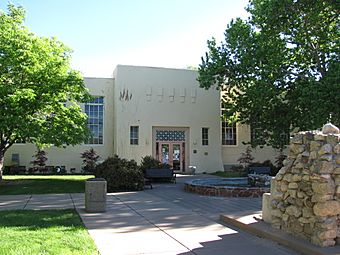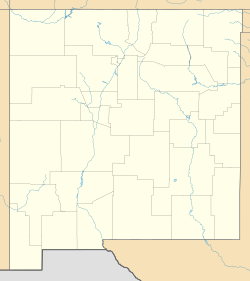Art Annex facts for kids
|
Art Annex
|
|

Art Annex, May 2010
|
|
| Location | 1901 Central Ave. NE Albuquerque, New Mexico |
|---|---|
| Built | 1926 |
| Architect | Trost & Trost Elson H. Norris |
| Architectural style | Pueblo Revival |
| NRHP reference No. | 88001540 |
Quick facts for kids Significant dates |
|
| Added to NRHP | September 22, 1988 |
The Art Annex is a special old building at the University of New Mexico in Albuquerque, New Mexico. It was built in 1926. This building was first used as the university's main library. It was designed by architects Trost & Trost and Elson H. Norris. The building looks unique, mixing Pueblo Revival architecture with some cool Mayan-style details. It's so important that it was added to the New Mexico State Register of Cultural Properties in 1975 and the National Register of Historic Places in 1988.
Contents
A Building's Story
From Books to Art Studios
The university's books used to be kept in another building called Hodgin Hall. But there were too many books by the 1920s! So, a new library was needed. This new library was built where an older university building, Hadley Hall, once stood. Hadley Hall had burned down in 1910.
The new library was designed by a company from El Paso called Trost & Trost. They worked with a local architect named Elson H. Norris. The building was finished in 1926 and cost about $42,000.
However, the university's collection of books grew very quickly. After only a few years, the building was too small again! In 1938, a much bigger library, called Zimmerman Library, was finished.
A New Purpose
After the new library opened, the old library building was changed. It became classrooms and art studios. This work was done with money from the Works Progress Administration. The Works Progress Administration was a program that helped create jobs during a tough economic time.
The building was updated again in 1984 and 1985. Today, it is used by students who are studying for their Master of Fine Arts degrees. They use the studios for painting, photography, printmaking, and experimental art.
What It Looks Like
Unique Design Features
The Art Annex is a one-story building with a basement. It has a flat roof. The walls are made of brick and covered with stucco. This building was built during a time when the University of New Mexico was trying out different building styles.
So, the Art Annex mixes several styles. You can see parts of Pueblo Revival architecture, Beaux-Arts architecture, and even Modern architecture. It also has some cool details inspired by Mayan Revival architecture.
The front of the building looks balanced and classic. It has many tall windows that open from the bottom. These windows let in lots of light for the reading areas inside. The outside walls are wider at the bottom, which makes them look very strong.
They are decorated with simple shapes and fake vigas. Vigas are wooden beams that stick out from walls in traditional Pueblo buildings. The first plans for the building also included a curvy roof edge, but that part was never built.



